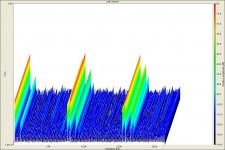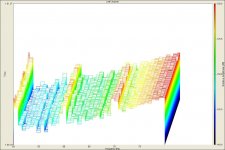I see it clearer now, but still not enough, especially what kind of measurement, THD or what? With THD (as a 1-dimensional lumped parameter vs freq) the picture is clear: slices of THD (ref signal level) vs freq, each slice for a different signal level, to see how the THD develops vs level. One would see things like increased THD with low levels when we have crossover distortion, for example. This would be rather easy to create with a bit of software. A set of plots for each individual HD component would also be possible and equally easy.What do I mean is,
X: frequency,
Y: level of output signal in respect to input signal,
Z: level of input signal.
But with things like IMD it's not so clear anymore, unless we can specify what "frequency" is supposed to mean exactly.
- Klaus
Wavebourn said:
Hi Bob;
nice to see you here again.
Do you know of some measurement system that is capable of drawing waterfalls with levels in decibels of error products in respect to input signal level, with frequency? Such graphs would be very revealing.
Hi Wavebourn,
Thanks. I don't know of such a system, but I would think that with today's PCs and excellent sound cards, something like that could be done, or maybe has been done. This reminds me of some of the kinds of neat software/measurement systems that are used for loudspeaker systems.
Cheers,
Bob
KSTR said:I see it clearer now, but still not enough, especially what kind of measurement, THD or what? With THD (as a 1-dimensional lumped parameter vs freq) the picture is clear: slices of THD (ref signal level) vs freq, each slice for a different signal level, to see how the THD develops vs level. One would see things like increased THD with low levels when we have crossover distortion, for example. This would be rather easy to create with a bit of software. A set of plots for each individual HD component would also be possible and equally easy.
But with things like IMD it's not so clear anymore, unless we can specify what "frequency" is supposed to mean exactly.
THD means Total, it is useless since more than one topology exists. What I mean, to show levels of harmonics on the 3-dimensional graph, be them single tone products, or products of multiple tones. With such a software you can see how extra products created by a sound reproduction chain depend on level of signal.
If such a software does not exist yet consider this idea as Public Domain.
Sounds like the "waterfall" commonly used to show the decay time vs frequency for speakers?
Except here we want the height of the waterfall to represent the THD product level vs input level??
Dunno, but I think the idea lends it self better to IM tests as the entire spectrum might be "lit up" by the right sort of IM test, then we could see the IM "mountain" change vs input (or output) level??
_-_-bear
Except here we want the height of the waterfall to represent the THD product level vs input level??
Dunno, but I think the idea lends it self better to IM tests as the entire spectrum might be "lit up" by the right sort of IM test, then we could see the IM "mountain" change vs input (or output) level??
_-_-bear
I have used a multitone test for looking at all manner of problems. However I don't find the test above useful. I use the spectral contamination test because the tones have no im or harmonics that overlap other products, nothing is hidden. Its very sensitive on transducers but electronics don't have as much trouble with it.
My lowly Juli@ car has distortion residuals at -115 dB or lower. Not bad for $150. I don't think instrumentation is a big issue today. Its understanding the output. Particularly the cause and effect relationship between circuit design, execution and measurements.
Last weekend I was at the Computer Audiophile symposium and given the opportunity, along with the others who made it, to hear subtle differences in exceptional playback systems. There were differences where by rights there shouldn't be but I felt that ascribing the causes for the differences and even making assumptions about right or wrong in the sound was not based on solid ground. The point being that hearing a difference is not enough to be sure of any cause. In this case there were 4 samples of possibly the best DAC ever made. However that is no guaranty that they all sound the same. Even location on a rack could bring issues that would not be obvious on initial inspection.
The same for opamps. Its possible that layout issues that a 5534 from Signetics(or Philips) would not have a problem with may cause issues with samples from a different vendor. This can lead to assumptions about the generic class of devices. Swapping in a socket is not definitive of anything except for that particular socket. I'll pass my experiences hot rodding commercial distortion analyzers on the test equipment thread.
My lowly Juli@ car has distortion residuals at -115 dB or lower. Not bad for $150. I don't think instrumentation is a big issue today. Its understanding the output. Particularly the cause and effect relationship between circuit design, execution and measurements.
Last weekend I was at the Computer Audiophile symposium and given the opportunity, along with the others who made it, to hear subtle differences in exceptional playback systems. There were differences where by rights there shouldn't be but I felt that ascribing the causes for the differences and even making assumptions about right or wrong in the sound was not based on solid ground. The point being that hearing a difference is not enough to be sure of any cause. In this case there were 4 samples of possibly the best DAC ever made. However that is no guaranty that they all sound the same. Even location on a rack could bring issues that would not be obvious on initial inspection.
The same for opamps. Its possible that layout issues that a 5534 from Signetics(or Philips) would not have a problem with may cause issues with samples from a different vendor. This can lead to assumptions about the generic class of devices. Swapping in a socket is not definitive of anything except for that particular socket. I'll pass my experiences hot rodding commercial distortion analyzers on the test equipment thread.
bear said:Sounds like the "waterfall" commonly used to show the decay time vs frequency for speakers?
Except here we want the height of the waterfall to represent the THD product level vs input level??
Dunno, but I think the idea lends it self better to IM tests as the entire spectrum might be "lit up" by the right sort of IM test, then we could see the IM "mountain" change vs input (or output) level??
You got it right. A "mountain" instead of a static picture. I.e. dependence of products of distortions (don't matter which distortions: intermodulation, non-linear, phase, whatelse) in dynamics.
john curl said:This is where I am using the AD825, kindly given to me by Scott Wurcer, (with advantages) to be a key part of the design.
It is a fine part, fast, symmetrical SR. Sounds fine, not dry, free of grain. You will find it noisy (12-15 nV/rtHz). I wonder what would be your opinion after some 6 months of listening tests.
PMA said:I often use it, as 2D THD spectrum averages non-periodic components and looks too optimistic.
Which software do you use Pavel?
1audio said:I have used a multitone test for looking at all manner of problems. However I don't find the test above useful. I use the spectral contamination test because the tones have no im or harmonics that overlap other products, nothing is hidden. Its very sensitive on transducers but electronics don't have as much trouble with it.
My lowly Juli@ car has distortion residuals at -115 dB or lower. Not bad for $150. I don't think instrumentation is a big issue today. Its understanding the output. Particularly the cause and effect relationship between circuit design, execution and measurements.
Last weekend I was at the Computer Audiophile symposium and given the opportunity, along with the others who made it, to hear subtle differences in exceptional playback systems. There were differences where by rights there shouldn't be but I felt that ascribing the causes for the differences and even making assumptions about right or wrong in the sound was not based on solid ground. The point being that hearing a difference is not enough to be sure of any cause. In this case there were 4 samples of possibly the best DAC ever made. However that is no guaranty that they all sound the same. Even location on a rack could bring issues that would not be obvious on initial inspection.
The same for opamps. Its possible that layout issues that a 5534 from Signetics(or Philips) would not have a problem with may cause issues with samples from a different vendor. This can lead to assumptions about the generic class of devices. Swapping in a socket is not definitive of anything except for that particular socket. I'll pass my experiences hot rodding commercial distortion analyzers on the test equipment thread.
Demian, thanks for a nice post. Perceptive.
I am intrigued by that Computer Audiophile symposium. I looked up the Computer Audiophile website but didn't find any report about the symposium. Any info on the type of equipment / DACs that was demo'd?
Thanks,
Jan Didden
PMA said:3D Surface View of SLab.
Which SLab, recording studio?
What card may be used for Solaris? I'm short of PCs, but have some SPARC thin servers.
PMA said:Looks like this, e.g.
Looks exactly what doctor prescribed, except signal level instead of time.
So, is it the same recording studio software? Do you use it's applications only, or create data by some another application?
PMA said:Now, the portion of interest may be enlarged - and you see variation in spectral components amplitudes, normally frozen in a 2D view.
Enough, I am already drooling! Can you answer my questions, please?
This one?PMA said:This is SpectraLab. Sorry, I have not checked yours, DIYaudio has not benn my full-time job yet
http://spectralab.software.informer.com/
PMA said:That's it. There are several versions, and even the old one can do it.
Thank you Pavel!
Which sound card do you think would be good to use?
- Status
- This old topic is closed. If you want to reopen this topic, contact a moderator using the "Report Post" button.
- Home
- Amplifiers
- Solid State
- pre standard two preamp, and development of measurement methods

